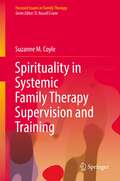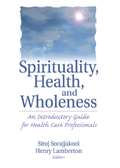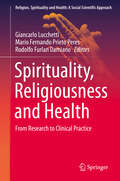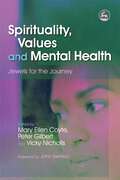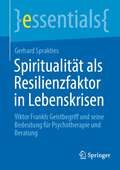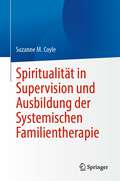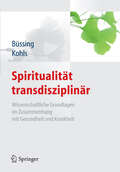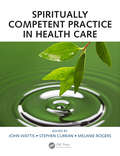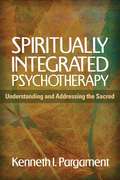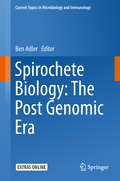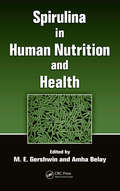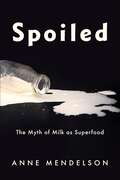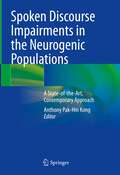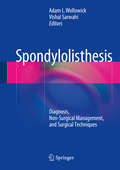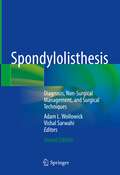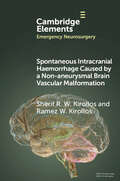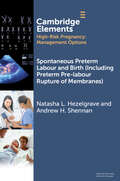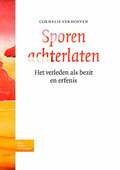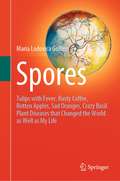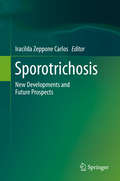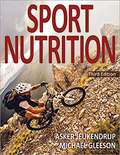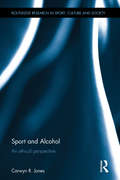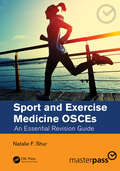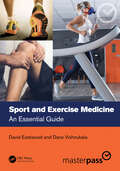- Table View
- List View
Spirituality in Systemic Family Therapy Supervision and Training (Focused Issues in Family Therapy)
by Suzanne M. CoyleThis book examines the implications of exploring spirituality through the lens of human relationships. It addresses systemic supervision and training and explores a systemic approach to the development of the self. The book provides an educational methodology that lays a foundation in describing an operational model of spirituality that is applicable for both theistic and nontheistic perspectives. In addition, it details how spirituality is itself a diversity as well as explores spirituality through a lens of diversity. In addition, a pilot research project on spirituality set in a MFT Live Supervision Group illustrates how to apply a systemic approach to spirituality. Finally, the book offers examples of practice using spirituality in various training settings.Key areas of coverage include:· How a systemic approach to spirituality enables the lens of relationship and diversity to enrich supervising and teaching family therapy emerging from the self of therapist concerns.· Theoretical perspectives that connect systemic practice with spirituality in an approach for family therapy.· How a systemic spiritual approach can be used in training marriage and family therapists.· Interventions that focus on how a relational systemic approach views transcendence and immanence from both clinical and spiritual perspectives.· Concepts that inform supervision and training with the goals of educating students to be spiritually literate and spiritually sensitive.· Barriers to implementing this approach with examples of how to address such obstacles.Spirituality in Systemic Family Therapy Supervision and Training is a must-have resource for researchers, professors, graduate students as well as clinicians, supervisors, and professionals in clinical psychology, family studies / family therapy, and public health as well as all interrelated disciplines.
Spirituality, Health, and Wholeness: An Introductory Guide for Health Care Professionals
by Siroj Sorajjakool Henry LambertonLearn to respond effectively and appropriately to spiritual needs in a health care setting Spirituality, Health, and Wholeness: An Introductory Guide for Health Care Professionals explores the principles of spiritual care as applied to clinical practice. This book focuses specifically on the significance of spirituality in clinical settings with practical suggestions on how to apply these principles in the healing process. With chapters that begin with clear objectives and end with guided questions, this valuable textbook provides a framework that will aid health care facilities in addressing spiritual needs in a clinical setting and help faculty in mentoring students in the field. This practical guide will help you learn when and how to address spiritual issues in health care with patients for whom illness creates a crisis of faith as well as those for whom it provides support. Spirituality, Health, and Wholeness highlights not only the importance of health care professionals in providing emotional, mental, and spiritual care, but the necessity for them to address their own spirituality as well. The book includes the experiences and case studies of skilled authorities mostly from the Judeo-Christian or Judaic tradition who identify principles that they found to be important in working with patients from a wide diversity of spiritual traditions. Spirituality, Health, and Wholeness provides you with detailed information on: "Ministryhealing"-a model of wholeness and healing that incorporates an integrated view of humanity through the four domains: spiritual, emotional, physical, and social the physiological impacts of humor and hope on mood, the neuroendocrine hormones, and the immune system spiritual coping with trauma-an overview of the research literature and how to address the spiritual coping needs and concerns of patients the role of faith in providing meaning to physical illness and the importance of the role of the health care professional in first understanding, and then assisting the patient in their struggle to find meaning the key components of spiritual care to increase the efficacy of spiritual caregivers the bereavement process with regard to religious, cultural, and gender variations, and the role of the healthcare professional in providing support This book shows you not only how to meet the spiritual needs of patients from a diversity of faith traditions, but how to overcome challenges to your own spirituality, such as "difficult" patients and patients whose cultural outlook is so different from your own it causes discomfort. Spirituality, Health, and Wholeness will help all health care professionals who want to bring spirituality into their medical, dental, nursing, occupational therapy, or physical therapy practice.
Spirituality, Religion, and Cognitive-Behavioral Therapy: A Guide for Clinicians
by David H. RosmarinSpirituality and religion are powerful forces in many people's lives, yet they are usually relegated to the periphery of cognitive-behavioral therapy (CBT) research and practice. This highly practical, nonsectarian book describes how to identify and work with psychologically relevant facets of spirituality in the context of evidence-based treatment. David H. Rosmarin draws on cutting-edge theory and research to provide clear guidelines for conceptualizing positive and negative aspects of spirituality pertaining to common clinical concerns. Concrete examples throughout the book illustrate collaborative ways to harness spiritual beliefs and practices to help bring about cognitive, behavioral, and affective change. Four reproducible handouts can be downloaded and printed in a convenient 8 1/2" x 11" size.
Spirituality, Religiousness and Health: From Research to Clinical Practice (Religion, Spirituality and Health: A Social Scientific Approach #4)
by Giancarlo Lucchetti Mario Fernando Prieto Peres Rodolfo Furlan DamianoThis book provides an overview of the research on spirituality, religiousness and health, including the most important studies, conceptualization, instruments for measurement, types of studies, challenges, and criticisms. It covers essential information on the influence of spirituality and religiousness (S/R) in mental and physical health, and provides guidance for its use in clinical practice. The book discusses the clinical implications of the research findings, including ethical issues, medical/health education, how to take a spiritual history, and challenges in addressing these issues, all based on studies showing the results of incorporating S/R in clinical practice. It contains case reports to facilitate learning, and suggests educational strategies to facilitate teaching S/R to health professionals and students.
Spirituality, Values and Mental Health: Jewels for the Journey
by David Mitchell Andrew Powell Brian Thorne John Swinton Neil Thompson Sarah Carr Peter Gilbert Nigel Mills Azim Kidwai John Foskett Suman Fernando Fozia Sarwar Premila Trevedi Choman Hardi Vicky Nicholls Peter Bates Fatima Kassam Arthur Hawes Cameron Langlands Veronica Dewan Ju Blencowe Julia Head Tom Gordon Frances Basset B Spalek Anne Roberts Paul Grey Mark Bones Ali Jan Haider Barbara Pointon Mary Ellen Coyte Kim Woodbridge Wendy Edwards Christopher Newell Chris Mackenna Abina Parshad-Griffin Thurstine Basset Sarajane Aris Luftha Meah Paul Chapple Bill K. W. M. FulfordSpirituality, religious belief and inclusive faith communities are important for mental well being but mental health practitioners have few guidelines for acknowledging these issues when working with service users. Spirituality, Values and Mental Health gathers together personal and professional contributions from mental health professionals, carers and mental health service users and survivors. It addresses the stigma that can surround both mental health and spirituality and explores the place of the spiritual in mental health care, teasing out its implications for research, education, training and good practice. This book is a welcome source of ideas and common-sense that is essential reading for mental health practitioners, carers and service users, chaplains, faith leaders, faith communities, as well as students and professionals working in the field of spirituality and mental health.
Spiritualität als Resilienzfaktor in Lebenskrisen: Viktor Frankls Geistbegriff und seine Bedeutung für Psychotherapie und Beratung (essentials)
by Gerhard SpraktiesDieses essential veranschaulicht Psychotherapeuten und Beratern die Bedeutung von Spiritualität für die Stärkung der persönlichen Resilienz. Wir leben in einer oftmals kräftezehrenden und schnelllebigen Zeit. Das 21. Jahrhundert begann mit einer Reihe Krisen von globalem Ausmaß: den Terroranschlägen von 9/11, der Finanzkrise, dem Klimawandel, der Coronapandemie und dem Ukrainekrieg. Viele Medien sind heute wahre Künstler in der Beschreibung misslingenden Lebens. Wer sich ständig mit negativen Nachrichten beschäftigt, läuft Gefahr, sein inneres seelisches Gleichgewicht zu verlieren. Er droht in eine von Trübsinn und Resignation geprägte Stimmung zu geraten. Der erfahrene Altenseelsorger und Logotherapeut Gerhard Sprakties zeigt auf, wie uns eine tiefe spirituelle Verankerung helfen kann, mit diesen Herausforderungen in konstruktiver Weise umzugehen.
Spiritualität in Supervision und Ausbildung der Systemischen Familientherapie
by Suzanne M. CoyleIn diesem Buch werden die Auswirkungen der Erforschung der Spiritualität durch die Linse der menschlichen Beziehungen untersucht. Es befasst sich mit systemischer Supervision und Ausbildung und erforscht einen systemischen Ansatz zur Entwicklung des Selbst. Das Buch bietet eine pädagogische Methodik, die eine Grundlage für die Beschreibung eines operativen Modells der Spiritualität schafft, das sowohl für theistische als auch für nicht-theistische Perspektiven geeignet ist. Darüber hinaus wird detailliert dargelegt, wie Spiritualität selbst eine Vielfalt ist, und Spiritualität wird durch die Linse der Vielfalt erforscht. Darüber hinaus veranschaulicht ein Pilotforschungsprojekt zum Thema Spiritualität in einer MFT-Live-Supervisionsgruppe, wie ein systemischer Ansatz auf Spiritualität angewendet werden kann. Schließlich bietet das Buch Beispiele für die praktische Anwendung von Spiritualität in verschiedenen Ausbildungssituationen.Zu den wichtigsten Themenbereichen gehören:- Wie ein systemischer Ansatz zur Spiritualität die Linse der Beziehung und der Vielfalt ermöglicht, um die Supervision und die Lehre der Familientherapie zu bereichern, die aus dem Selbst der Therapeuten hervorgeht.- Theoretische Perspektiven, die systemische Praxis mit Spiritualität in einem Ansatz für Familientherapie verbinden.- Wie ein systemischer spiritueller Ansatz in der Ausbildung von Ehe- und Familientherapeuten eingesetzt werden kann.- Interventionen, die sich darauf konzentrieren, wie ein relationaler systemischer Ansatz Transzendenz und Immanenz sowohl aus klinischer als auch aus spiritueller Perspektive betrachtet.- Konzepte, die in die Supervision und Ausbildung einfließen, mit dem Ziel, die Studierenden zu spiritueller Kompetenz und spiritueller Sensibilität zu erziehen.- Hindernisse bei der Umsetzung dieses Ansatzes mit Beispielen, wie solche Hindernisse angegangen werden können.Spiritualität in der systemischen Familientherapie-Supervision und -Ausbildung ist ein unverzichtbares Hilfsmittel für Forscher, Professoren, Doktoranden sowie Kliniker, Supervisoren und Fachleute in den Bereichen klinische Psychologie, Familienstudien/Familientherapie und öffentliches Gesundheitswesen sowie in allen damit verbundenen Disziplinen.
Spiritualität transdisziplinär
by Niko Kohls Arndt BüssingIm Kontext der Gesundheitswissenschaften wird vor allem im angloamerikanischen Raum der Zusammenhang von Spiritualität, Religiosität, Achtsamkeit mit Lebensqualität und Gesundheit erforscht. Viele empirische Studien belegen, dass dieser Zusammenhang medizinisch relevant sein kann. Die Bedeutung von Spiritualität wird zunehmend nicht nur innerhalb der Palliativ- und Schmerzmedizin erkannt, sondern auch im Rahmen der Gesundheitspsychologie, Lebensqualitäts- und Versorgungsforschung. An der Schnittstelle von subjektiv empfundener Bedeutsamkeit und empirisch belegbarer Gesundheitsrelevanz ist die Verbindung mit den transdisziplinären Forschungsfragestellungen zu sehen, deren Bearbeitung sich dieses Buch verpflichtet sieht. Geschrieben für Praktiker (Ärzte, Psychologen, Analytiker und Pflegende) sowie für Studierende und Forschende aus den Bereichen der Medizin, Pflegewissenschaft, Psychologie, Soziologie, Theologie, Religionswissenschaft, Philosophie und Kulturanthropologie.
Spiritually Competent Practice in Health Care
by John Wattis Stephen Curran Melanie RogersThis book will be of tremendous use to all healthcare professionals from physicians to nurses to social workers, rehabilitation therapists, and chaplains. The pathway taken here is a sensible and reasonable one, emphasizing a patient-centred approach that underscores the importance of spiritually competent care. The Editors do an excellent job of describing how to integrate spirituality into patient care for all of the different healthcare professionals. They also emphasize the importance of an evidence-based approach that is guided by research. This book provides superb guidelines that will be enormously helpful to every healthcare professional. Harold G Koenig, M.D., Professor of Psychiatry & Behavioral Sciences, Duke University Medical Center, Durham, North Carolina This practical guide tackles the important issues of spirituality in health care, emphasising the role of organisations in developing a culture of leadership and management that facilitates spiritual care. Spirituality is a central part of holistic care that addresses physical, mental, emotional and spiritual aspects of care in an integrated way. The chapters are written by experts in their fields, pitched at the practitioner level rather than addressing ‘spirituality’ as a purely theoretical concept. Each one describes the realities of spiritually competent practice and show how it can be taught and put into practice in a variety of areas and settings, including Undergraduate and Postgraduate education Acute healthcare settings Mental health Primary care End of Life Care Creative organisations Social services Ideal for practitioners, educators, trainees and managers in nursing and healthcare, the book is also relevant reading for occupational therapists, physiotherapists, social workers and psychologists.
Spiritually Integrated Psychotherapy
by Kenneth PargamentFrom a leading researcher and practitioner, this volume provides an innovative framework for understanding the role of spirituality in people's lives and its relevance to the work done in psychotherapy. It offers fresh, practical ideas for creating a spiritual dialogue with clients, assessing spirituality as a part of their problems and solutions, and helping them draw on spiritual resources in times of stress. Written from a nonsectarian perspective, the book encompasses both traditional and nontraditional forms of spirituality. It is grounded in current findings from psychotherapy research and the psychology of religion, and includes a wealth of evocative case material.
Spirochete Biology: The Post Genomic Era (Current Topics in Microbiology and Immunology #415)
by Ben AdlerSpirochetes comprise a fascinating group of bacteria. Although diverse in terms of their habitat, ecology and infectivity for vertebrate and non-vertebrate hosts, they are often considered together because of their similar cellular morphologies. This volume brings together an international group of experts to provide essential insights into spirochete biology, with an emphasis on recent advances made possible by the availability of genome sequences. As such, it offers a valuable resource for microbiologists and other scientists with an interest in spirochete biology.
Spirulina in Human Nutrition and Health
by M. E. Gershwin Amha BelayAstonishingly rich in nutrients, Spirulina is one of the most popular and well researched functional foods in the multi-billion dollar global food supplement market. This ancient species provides readily bioavailable protein along with carotenoids, essential fatty acids, vitamins, and minerals and has therapeutic applications in non-communicable di
Spoiled: The Myth of Milk as Superfood (Arts and Traditions of the Table: Perspectives on Culinary History)
by Anne MendelsonWhy is cows’ milk, which few nonwhite people can digest, promoted as a science-backed dietary necessity in countries where the majority of the population is lactose-intolerant? Why are gigantic new dairy farms permitted to deplete the sparse water resources of desert ecosystems? Why do thousands of U.S. dairy farmers every year give up after struggling to recoup production costs against plummeting wholesale prices?Exploring these questions and many more, Spoiled is an unflinching and meticulous critique of the glorification of fluid milk and its alleged universal benefits. Anne Mendelson’s groundbreaking book chronicles the story of milk from the Stone Age peoples who first domesticated cows, goats, and sheep to today’s troubled dairy industry. Spoiled shows that drinking fresh milk was rare until Western scientific experts who were unaware of genetic differences in the ability to digest lactose deemed it superior to traditional fermented dairy products. Their flawed beliefs fueled the growth of a massive and environmentally devastating industry that turned milk into a cheap, ubiquitous commodity.Mendelson’s wide-ranging account also examines the consequences of homogenization and refrigeration technologies, the toll that modern farming takes on dairy cows, and changing perceptions of raw milk since the advent of pasteurization. Unraveling the myths and misconceptions that prop up the dairy industry, Spoiled calls for more sustainable, healthful futures in our relationship with milk and the animals that provide it.
Spoken Discourse Impairments in the Neurogenic Populations: A State-of-the-Art, Contemporary Approach
by Anthony Pak-Hin KongThis comprehensive volume provides balanced and easily readable chapters on contemporary topics around discourse production in patients with neurogenic disorders. Discourse broadly refers to a unit of language longer than a single sentence, typically used in a spoken or written format to express ideas, feelings, and opinions or to interact with others. As the field of research in speech-language pathology, aphasia and related neurogenic disorders, and clinical decision-making to manage neurogenic impairments is rapidly expanding, there has been an increased focus on discourse analysis and therapy to enable patients to speak well again. Various user groups and people with lived experience (e.g., aphasia, dementia, traumatic brain injury, right hemisphere damage, etc.) are also increasingly focused on the impact of neurogenic impairments on domains of conversation and changes in language skills beyond the smaller linguistic components of single words and sentences that are traditionally supported by speech-language therapy. The first part of this book details and discusses the basic principles, historical perspectives (history and developmental milestones), neural basis, and recent evolutions and advancement of discourse analysis in speakers with acquired communication disorders. The second part of the book outlines and illustrates current methods for discourse elicitation and analysis across different clinical populations. Recent leaps forward in technology that can assist in the recording, processing, and analysis of discourse will be highlighted. The final part of book reviews and summarizes key developments of various evidenced-based training strategies, interventions, and treatment programs, as well as utilization of innovative technology to clinically improve neurogenic disordered discourse. This is an ideal guide for researchers, clinicians, and students in the field of communication sciences and disorders, speech and language therapy, gerontology, (neuro-)linguistics, psychology, and related fields in clinical medicine.
Spondylolisthesis
by Adam L. Wollowick Vishal SarwahiThis comprehensive text is the most current and definitive source for information related to the care of adult and pediatric patients with spondylolisthesis. It contains a complete analysis of this common, yet intricate spinal condition, including basic science, diagnosis, non-surgical management, surgical techniques (including minimally invasive options) and outcomes. The management of the various types of spondylolisthesis requires a thorough understanding of both fundamental principles and subtle nuances, which are highlighted here in three sections. Part I details the basic principles, diagnosis and non-surgical management of spondylolisthesis, including imaging and classification. Part II covers surgical management, including a step-by-step discussion of strategies, techniques and tips that are necessary to apply standard procedures to this specific disorder. Procedures that are covered include decompression, spinal fusion from various approaches, and the latest minimally invasive techniques. Part III discusses the outcomes and complications of surgical treatment. Written and edited by top clinicians in the field, this book will be an invaluable resource for orthopedic and neurological spine surgeons, rehabilitation physicians, residents, fellows, and any caregiver who treats the spine.
Spondylolisthesis: Diagnosis, Non-Surgical Management, and Surgical Techniques
by Adam L. Wollowick Vishal SarwahiNow in a fully revised and expanded second edition, this comprehensive text remains the definitive source for information related to the care of adult and pediatric patients with spondylolisthesis. It presents a complete analysis of this common yet intricate spinal condition, including basic science, diagnosis, non-surgical management, surgical techniques (including minimally invasive options and biologics) and outcomes. The management of the various types of spondylolisthesis requires a thorough understanding of both fundamental principles and subtle nuances, which are highlighted here in three sections. Part I details the basic principles, diagnosis and non-surgical management of spondylolisthesis, including anatomy and biomechanics, clinical evaluation of both adult and pediatric patients, and imaging and classification. Part II covers surgical management with a step-by-step discussion of strategies, techniques and tips that are necessary to apply standard procedures to this specific disorder. Procedures that are covered here include decompression, spinal fusion from various approaches, and the latest minimally invasive and endoscopic techniques. Part III discusses the outcomes and complications of surgical treatment, as well as interoperative neuro-monitoring and value considerations. Written and edited by top clinicians in the field, Spondylolisthesis remains an invaluable resource for orthopedic and neurological spine surgeons, rehabilitation physicians, residents, fellows, and any caregiver who treats the spine.
Spontaneous Intracranial Haemorrhage Caused by a Non-aneurysmal Brain Vascular Malformation (Elements in Emergency Neurosurgery)
by Sherif R. Kirollos Ramez W. KirollosEmergency management of intracranial haemorrhage due to AVMs, DAVFs, and cavernomas involves addressing both the haemorrhage consequences and the underlying vascular lesion. Clinical evaluation and diagnostic workup identify factors necessitating urgent intervention and define the vascular lesion. Urgent intervention may involve ICH management with increased ICP or CSF drainage for acute hydrocephalus. Definitive intervention for the vascular lesion may coincide with or follow evacuation of the intracranial haematoma. Careful considerations and precautions are taken independently or concurrently with the vascular lesion. Indications and timing for AVM intervention involve determining the bleeding source, evaluating mass effect, and assessing the utility of existing ICH for microsurgical AVM resection. Modified microsurgical techniques ensure safety. DAVF intervention with ICH or ASDH requires urgent endovascular treatment and surgical nuances. Cavernoma intervention follows straightforward indications and timing, while brainstem cavernomas require careful consideration of early intervention. Aftercare and a team approach are vital.
Spontaneous Preterm Labour and Birth (Elements in High Risk Pregnancy: Management Options)
by Natasha L. Hezelgrave Andrew ShennanSpontaneous preterm birth remains the leading cause of neonatal death, and the second leading cause of mortality worldwide in children below 5 years of age. The causes of preterm birth are multifactorial, likely contributing to why significant progress in reducing the incidence has been slow. This Element contains the most up to date evidence regarding the aetiology, epidemiology and management of pregnancies at risk of, or complicated by spontaneous preterm birth and preterm prelabour rupture of membranes, concentrating largely on those aspects potentially amendable to preventative intervention, i.e. cervical dysfunction and premature uterine contractility, as well as strategies to improve outcomes for infants born prematurely.
Sporen achterlaten
by Cornelis VerhoevenEen drietal beschouwingen over het verleden in het kader van de menselijke levensloop. Ons verleden als bezit opent mogelijkheden en initieert beloftes, maar beperkt beiden tezelfdertijd. Ons verleden bepaalt daardoor de inhoud van ons bestaan en de rijpheid van onze persoon. De beschouwingen vormen een schoolvoorbeeld van verhandelingen over thema's in de levensloop die het mogelijk maken te refereren aan gebeurtenissen in de eigen levensloop, als uitgangspunt of als kader. Zo kristalliseert zich altijd een persoonlijke balans uit.
Spores: Tulips with Fever, Rusty Coffee, Rotten Apples, Sad Oranges, Crazy Basil. Plant Diseases that Changed the World as Well as My Life
by Maria Lodovica GullinoThis book aims to describe, though in a quite light way, the social role of plant diseases, letting the reader know the topical importance of plant pathology, as well as the role of plant pathologists in our society. Plant diseases caused, in the past, significant economic losses, deaths, famine, wars, and migration. Some of them marked the history of entire countries. One example among many: the potato late blight in Ireland in 1845. Today plant diseases are still the cause of deaths, often silent, in developing countries, and relevant economic losses in the industrialized ones. This book, written with much passion, neither wants to be a plant pathology text. On the contrary, it wants to describe, in simple words, often enriched by the author's personal experience, various plant diseases that, in different times and countries, did cause severe losses and damages. Besides the so-called “historical plant diseases”, in the process of writing this book, she wanted to describe also some diseases that, though not causing famine or billions of losses, because of their peculiarity, might be of interest for the readers. Thus, this book has not been conceived and written for experts, but for a broader audience, of different ages, willing to learn more about plant health and to understand the reasons why so many people in the past and nowadays choose to be plant pathologists. This is because plants produce most of the food that we consume, that we expect to be healthy and safe, and because plants make the world beautiful. The title “Spores” is evocative of the reproduction mean of fungi. Spores are small, light structures, often moving fast. The chapters of this book are short and concise. Just like spores!
Sporotrichosis
by Iracilda Zeppone CarlosThe book presents current affairs of Sporotrichosis as emergent disease with emphasis on the potential factors associated with genetic polymorphisms in Sporothrix complex. Constitutive and inducible factors play an essential role in the response of the fungal cell to the environment as determinant in the immunopathogenicity, highlighting clinical forms of Sporotrichosis and host immunocompetence. Also, a current issue interest in zoonotic transmission showing that a cat is the animal species most affected by Sporothrix species and their importance in the involvement in the human transmission. Readers can associate parameters of experimental immune response to disease development as well as the diagnostic, prophylaxis, and therapies that can be applied in the near future.
Sport Nutrition
by Michael Gleeson Asker Jeukendrup<p>Sport Nutrition, Third Edition, presents the principles and rationale for current nutrition guidelines for athletes. Using a physiological basis, this text provides an in-depth look at the science behind sport nutrition. Students will come away with an understanding of nutrition as it relates to sport and the influence of nutrition on performance, training, and recovery. <p>This text is organized with the student in mind, with content sequenced in a logical order that puts building blocks in place to facilitate greater comprehension as more advanced topics are introduced. The book moves from general principles of nutrition and nutrient requirements to estimating and fulfilling energy needs with the appropriate combinations of macronutrients and micronutrients. Supplements are addressed from a scientific standpoint, followed by the influence of nutrition on training adaptations, immune function, body composition, weight management, and eating disorders. The new chapter on personalized nutrition covers periodized nutrition, gender differences, and special populations (young athletes, older athletes, and diabetic athletes) and offers practical examples from specific sports. </p>
Sport and Alcohol: An ethical perspective (Routledge Research in Sport, Culture and Society)
by Carwyn Rh. JonesThere is a clear sense in which sport has played, and continues to play an important role in the normalization and legitimization of routine, excessive and problem drinking; sport and alcohol have become inextricably linked. Alcohol companies provide funding in the form of sponsorship, fans consume alcohol when watching, and players celebrate, bond and relax with alcohol. Sport and Alcohol: an ethical perspective aims to critically examine the various ways in which sport and alcohol interact. In doing so, the book casts an ethical eye over the following topics: Society’s relationship with alcohol Sponsorship and marketing of alcohol through sport and its effect on children Sport’s alcohol-tolerant ethos, problematic drinking practices and rituals Punishment and discipline in relation to athletes’ drink-related bad behavior Alcoholism in the context of sport and the need for a greater understanding of the condition, how it develops and what can be done The status of athletes as role models Offering a much-needed critical assessment of an important issue in contemporary sport and society, Sport and Alcohol is essential reading for those interested in the social, cultural or philosophical study of sport in general and sport and alcohol in particular.
Sport and Exercise Medicine OSCEs: An Essential Revision Guide
by Natalie F. ShurAs the only text on the market for Sport and Exercise Medicine objective structured clinical examinations (OSCEs), this is an invaluable guide for those studying sport and exercise medicine and sitting examinations. Whilst specifically targeted at the OSCE, this book will have much wider appeal throughout the clinical setting. Sport and Exercise Medicine is a new and developing specialty and there has been a rapid increase in the number of universities offering MSc degrees in Sport and Exercise Medicine and more candidates year on the year sitting the Faculty of Sport and Exercise Medicine (FSEM) diploma exam. It is a niche specialty, with very little content taught at an undergraduate level, therefore knowing the material that is examined is often challenging compared with other specialties. This book provides the content to fill that need. The book is divided into sections based on the main topics that arise in sport and exercise medicine OSCEs, with both core knowledge and practical tips to ensure a fluid and confident performance by the examinee in every station. A wide range of readers will benefit from this book, including those about to sit a postgraduate examination in sport and exercise medicine or those enrolled in a postgraduate certificate or master’s course in the specialty. It will also be useful to doctors and allied healthcare professionals, such as physiotherapists, sports therapists, podiatrists and nurses, as well as undergraduate students. Further, the young clinician who is just starting out and wants to build their confidence in musculoskeletal assessment and presenting to seniors will gain much from reading this book.
Sport and Exercise Medicine: An Essential Guide (Master Pass Series)
by David Eastwood Dane VishnubalaThe complete guide for all candidates studying and working in the field of sport and exercise medicine, including higher specialist training and post graduate examinations. This revision guide covers all key elements of the UK National Curriculum in Sport and Exercise Medicine. Key features to facilitate learning include: A pictorial summary at the start of each chapter ‘Clinical consideration’ sections that show how knowledge can be applied to working clinical practice MCQ questions for each chapter, including answers MFSEM examination candidates, MSc students in sport and exercise medicine, sport and exercise medicine specialist trainee doctors, physiotherapists and general practitioners with an extended role in musculoskeletal or sport and exercise medicine will all benefit from this new text.
